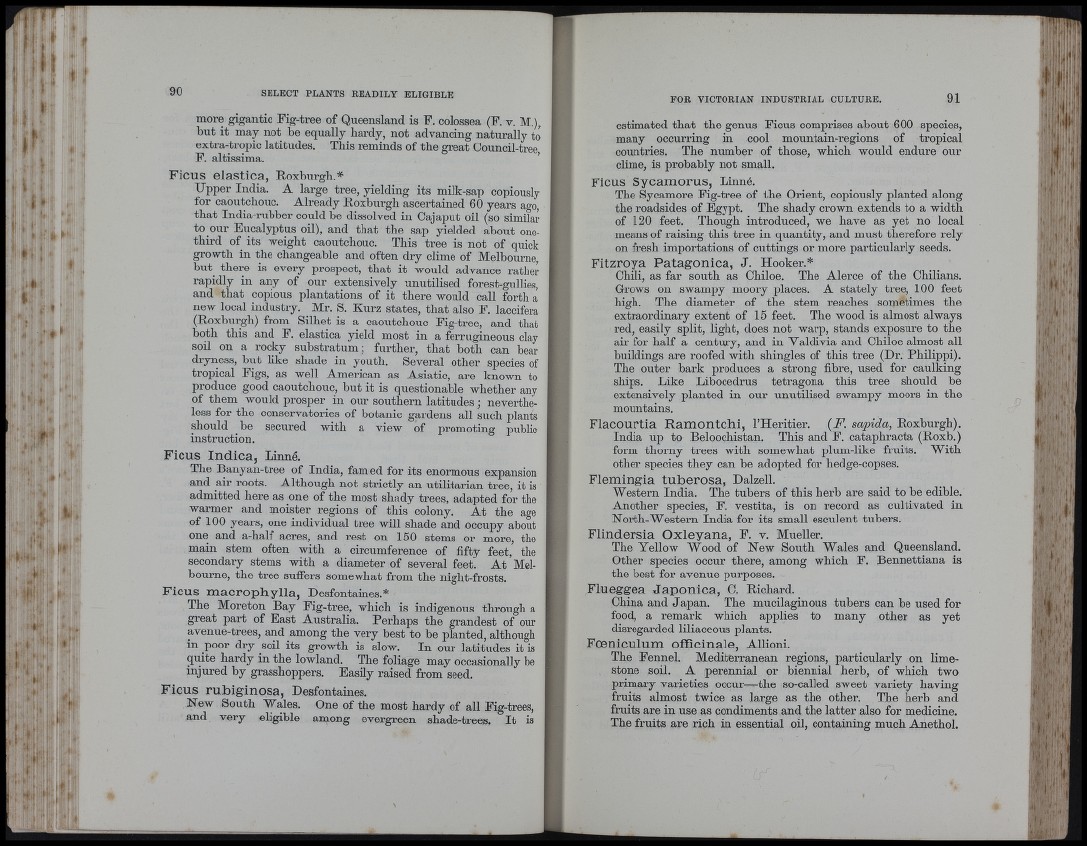
4 '
( 111,
iiii
more gigantic Fig-tree of Queensland is F. colossea (F. v. M.),
but it may not be equally hardy, not advancing naturally ta
extra-tropic latitudes. This reminds of the great Council-tree,
F. altissima. ’
Ficus elástica, Roxburgh.*
Upper India. A large tree, yielding its milk-sap copiously
for caoutchouc. Already Roxburgh ascertained 60 years ago,
th a t India-rubber could be dissolved in Cajaput oil (so similar
to our Eucalyptus oil), and that the sap yielded about one-
third of its weight caoutchouc. This tree is not of quick
growth in the changeable and often dry clime of Melbourne,
but_ there is every prospect, that it would advance rather
rapidly in any of our extensively unutilised forest-gulhes,
and that copious plantations of it there would call forth a
new local industry. Mr. S. Kurz states, that also F. laccifera
(Roxburgh) from Silhet is a caoutchouc Fig-tree, and that
both this and F. elástica yield most in a ferrugineous clay
soil on a rocky substratum; further, that both can bear
dryness, but like shade in youth. Several other species of
tropical Figs, as well American as Asiatic, are known to
produce good caoutchouc, bnt it is questionable whether any
of them would prosper in our southern latitudes ; nevertheless
for tbe conservatories of botanic gardens all such plants
should be secured with a view of promoting public
instruction.
Ficus Indica, Linné.
The Banyan-tree of India, famed for its enormous expansion
and air roots. Although not strictly an utilitarian tree, it is
admitted here as one of the most shady trees, adapted for the
warmer and moister regions of this colony. A t the age
of 100 years, one individual tree will shade and occupy about
one and a-half acres, and rest on 150 stems or more, the
main stem often with a circumference of fifty feet, the
secondary stems with a diameter of several feet. A t Melbourne,
the tree suffers somewhat from the night-frosts.
Ficus macrophylla, Desfontaines.*
Tbe Moreton Bay Eig-tree, which is indigenous through a
great part of East Australia. Perhaps the grandest of our
avenue-trees, and among the very best to be planted, although
in poor dry soil its growth is slow. In onr latitudes it is
quite hardy in the lowland. The foliage may occasionally be
injured by grasshoppers. Easily raised from seed.
Ficus rubiginosa, Desfontaines.
New South Wales. One of the most hardy of all Fig-trees,
and very eligible among evergreen shade-trees. I t is
estimated th a t the genus Ficus comprises about 600 species,
many occurring in cool monntain-regions of tropical
countries. The number of those, which would endure our
clime, is probably not small.
Ficus Sycamorus, Linné.
The Sycamore Eig-tree of the Orient, copiously planted along
the roadsides of Egypt. The shady crown extends to a width
of 120 feet. Though introduced, we have as yet no local
means of raising this tree in quantity, and must therefore rely
on fresh importations of cuttings or more particularly seeds.
Fitzroya Patagónica, J . Hooker.*
Chili, as far south as Chiloe. The Alerce of the Chilians.
Grows on swampy moory places. A stately tree, 100 feet
high. The diameter of the stem reaches sometimes the
extraordinary extent of 15 feet. The wood is almost always
red, easily split, light, does not warp, stands exposure to the
air for half a century, and in Valdivia and Chiloe almost all
buildings are roofed with shingles of this tree (Dr. Philippi).
The outer bark produces a strong fibre, used for caulking
ships. Like Libocedrus tetragona tbis tree should be
extensively planted in our unutilised swampy moors in the
mountains.
Flacourtia Ramontchi, I’Heritier. {F. sapida, Roxburgh).
India up to Beloochistan. This and F. cataphracta (Roxb.)
form thorny trees with somewhat plum-like fruits. With
other species they can he adopted for hedge-copses.
Flemingia tuberosa, Dalzell.
Western India. The tubers of this herb are said to be edible.
Another species, F. vestita, is on record as cultivated in
North-Western India for its small esculent tubers.
Flindersia Oxleyana, F. v. Mueller.
The Yellow Wood of New South Wales and Queensland.
Other species occur there, among which F. Bennettiana is
the best for avenue purposes.
Flueggea Japónica, C. Richard.
China and Japan. The mucilaginous tubers can he used for
food, a remark which applies to many other as yet
disregarded liliaceous plants.
Foeniculum officinale, Allioni.
The Fennel. Mediterranean regions, particularly on limestone
soil. A perennial or biennial herb, of which two
primary varieties occur—the so-called sweet variety having
fruits almost twice as large as the other. The herb and
fruits are in use as condiments and the latter also for medicine.
The fruits are rich in essential oil, containing much Anethol.
Í
f t,
I
I J,
1 '
I
J
A
■i
J
i I